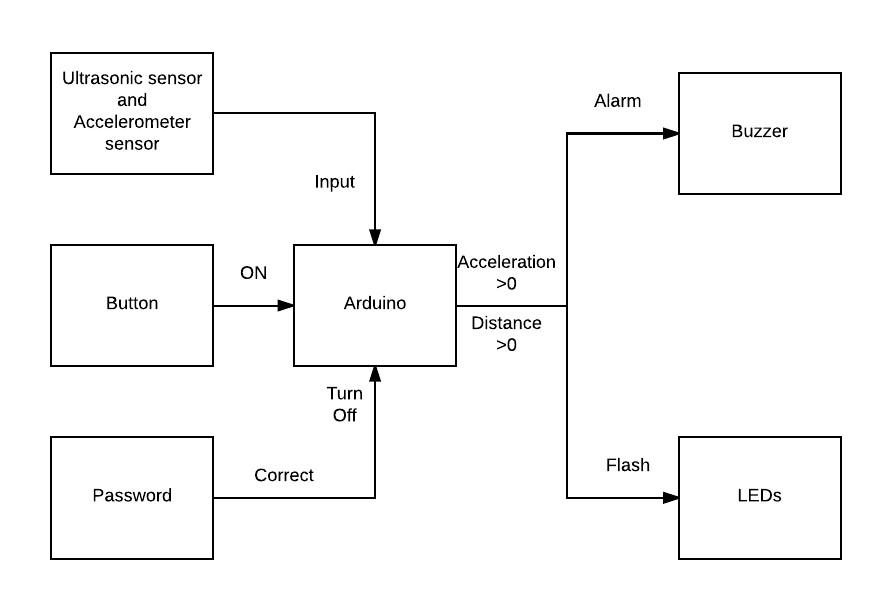Group Members:
Yulun Yao - yuluny2 (ECE 110)
Joshua Sanchez - jsanch84 (ECE 120)
Wentao Jiang - wentaoj2 (ECE 110)
Introduction
Statement of Purpose
When you walk into Grainger Library, you'll see a sign that warns of high theft, particularly of laptops. You might also see a similar signs in libraries at other universities or municipalities. The ubiquity of these signs in libraries is indicative of how common the issue of laptop theft is in these establishments. Current software-based solutions, such as VirtuaLock and LAlarm, require network connections and active computer interactions. Current hardware-based solutions, such as the Targus DEFCON 1 system, are expensive. LibSafe+ will act as an affordable and effective theft alert and deterrent system that forgoes the issues of software-based alarms by using efficiently designed hardware to detect theft and alert the user and those around the area of theft.
Background Research
Libraries are among the places where laptops are most frequently stolen1. Stemming from the work environment of the library, laptop users may often stray away from their devices for a time, or even fall asleep with their device. This problem is an especially huge concern for libraries within university systems, who dedicate training sessions, informational databases, and police resources to preventing theft2.
Current solutions to this problem are largely software-based. The most inherent issue with a software-based solution is the fact that it requires either information/power from the computer or an active internet connection. The most effective solutions so far are hardware-based. Libraries, when advising on the issue of preventing laptop theft, usually recommend laptop locks3.
Design Details
Block Diagram / Flow Chart
System Overview
The student may put the laptop on the ultrasonic sensor, and press the button on one side of the device to turn it on. The student may connect the device to to the USB Charger, in case the battery is out of power. When someone tries to take the laptop, the ultrasonic sensor will detect that the laptop is leaving, and the device will alarm(buzzer) and the LEDs on it start to flash. In case that someone take the laptop and the security system together, there is another accelerometer sensor on the bottom. If the device is moved relative to the table vertically even a little bit, the accelerometer sensor will detect it and the device will also alarm.
To disable the device, the owner needs to use the password he or she created. The password system is consisted of 4 switches and is operated by a logic gate circuit. Only turning the correct switches on can one disable the device. This function may be realized through some Arduino coding. After the device is disabled, the student can safely remove the security system and continues working. The next time the owner wants to use the security system, he or she may just repeat the process above.4 switches and is operated by a logic gate circuit. Only turning the correct switches on can one disable the device. This function may be realized through some Arduino coding. After the device is disabled, the student can safely remove the security system and continues working. The next time the owner wants to use the security system, he or she may just repeat the process above.
"One possible solution"
Parts
Accelerometer sensor (SparkFun Triple Axis Accelerometer Breakout - MMA8452Q (with Headers))
Ultrasonic sensor (Ultrasonic Sensor - HC-SR04)
Arduino (Red Board)
Buzzer (Sparkfun Redbot Buzzer)
LEDs
Wires and resistors
Switches
USB Charger
Battery holder (Battery Holder - 4xAA Square)
Some logic gate chips
Possible Challenges
·As all of our members are not proficient in programming, the biggest problem may be setting up the password system, which allows the customers to set their own passwords.
·We are still not sure about how to make the case that is strong enough to withstand the weight of some typical laptops. We may want to make sure that the device is strong enough to withstand the weight of an Alienware.
·Since some people may accidently move his own device, which may cause the device to alarm, we need to come up with some ways to reduce the possibility of such accidents.
·We may also have to deal with the accuracy and sensitivity of the sensors.
References
2. https://security.berkeley.edu/resources/best-practices-how-articles/preventing-laptop-theft
3. http://blog.superuser.com/2011/08/22/computers-and-college-part-iii-protecting-your-computer/

